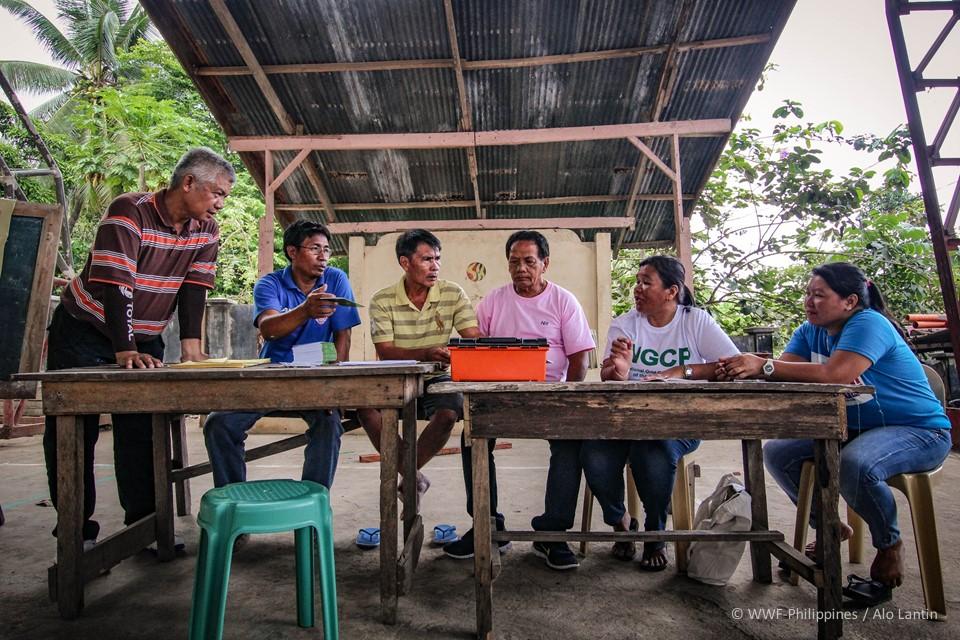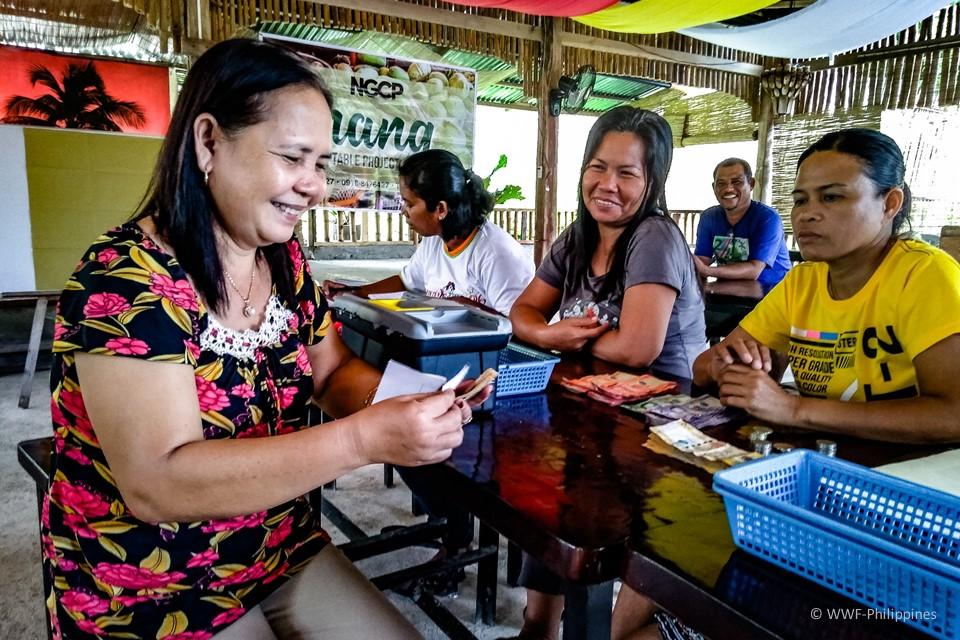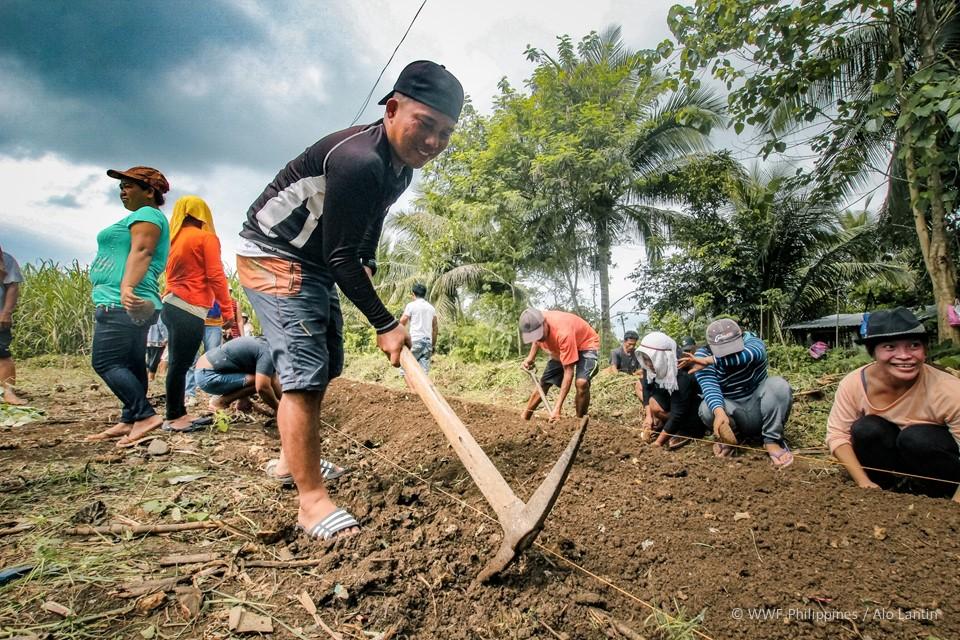In These Times of Livelihood Crisis, Village Banks are Bringing Communities Together
August 2020

Board members of a village bank in Zamboanga practice running their own GSLA. Village banks are an important financial support system for struggling communities, and are a way of forging bonds and building trust among its members – crucial elements for a town that is faced with a sweeping pandemic. Photograph © Alo Lantin / WWF-Philippines
Millions of Filipinos have found their livelihoods threatened under the shadow of the COVID-19 pandemic. Transportation bans and social distancing measures have grounded whole industries to a halt. Families now struggle with a litany of problems brought about by a lack of income – but a social solution exists, and it’s saving whole communities.
Introducing the village bank.

Women from Jagna, Bohol, count out money recently added to their GSLA communal pot. A board is elected by the community to run each village bank. The board then manages the fund, with the community voting on what they would like to invest in. Photograph © Alo Lantin / WWF-Philippines
What is a village bank?
Village banks are known also as GSLAs, or Group Savings and Loan Associations. But what differentiates a village bank from a regular bank? World Wide Fund for Nature (WWF) Philippines Sustainable Food Systems Project Manager Monci Hinay explains.
“The GSLA is a democratized form of savings mobilization. It's anchored on community partnerships. Its basic principle is that members of a self-selected group voluntarily come together to form a GSLA, through which they save money through the purchase of shares,” explains Hinay. A seasoned agriculturalist and an expert on rural livelihoods, Hinay, together with the WWF-Philippines Sustainable Food Systems team, has overseen the establishment of village banks all across the country, with combined savings of almost two million pesos over the past three years.
For each village bank, a board is elected and funds are collected and pooled monthly, or as decided in the by-laws which the townships create together. The funds are to be used by members of the village bank. All fund use is democratic – all cash withdrawals are voted on by the members of the village bank, ensuring all expenditures are made with the consent of the community. Withdrawals are then used for anything from relief aid to community construction projects.
“The primary objective is to provide simple savings and loan facilities within a community, especially for those that do not have access to formal financial services,” added Hinay.
In times of pandemic, rural livelihoods are impacted, incomes reduced, and financial aid hard to come by and to access. As money grows short, the village banks provide communities with easy access to much-needed financial aid. With an additional buffer of financial insurance, these communities continue on underneath the pandemic, secure in the fact that they have the means to take care of themselves.

A community in Lanao del Norte, beneficiary of Hinay and his team’s village banks, enjoy the fruits of their communal farm. Over the years, these village banks have brought townsfolk closer, building communities anchored on trust that are capable of weathering hard times together. Photograph © Alo Lantin / WWF-Philippines
Finding Community in Desperate Times
In these times of troubled livelihoods, these village banks provide much needed relief – but the bonds they create between community members are just as valuable an outcome.
“Savings are a form of trust, and so are these GSLAs. That’s what we’re building as well, trust… Over time, our communities were able to establish a sense of kinship within themselves. The GSLAs helped them get to know each other better. That is the best position to be in when you’re weathering out a disaster,” explains Hinay. With the bonds forged through these GSLAs, adds Hinay, community members can rest easy knowing that they can rely on their neighbors in times of need.
Communities with GSLAs have flourished over the years, narrates Hinay, and have been able to weather the pandemic well. He cites communities in Bohol, Cebu, and Ormoc who, through their village banks, have seen great developments in food and livelihood security and local infrastructure – all paid for and decided upon by the townsfolk themselves.
“I wish this was something that all communities across the country could enjoy! These GSLAs are very important for times such as our current situation. I would definitely recommend them,” continued Hinay. The bonds and the social and financial support provided by these village banks are a necessary step toward building sustainable communities.

A farmer breaks new ground in Negros for his town’s communal farm. Coupled with food security and livelihood projects, each village bank promises new life and sustainable resource security even in the face of hardships and pandemic. Photograph © Alo Lantin / WWF-Philippines
“These village banks are important. They are bringing communities together. This is love for our country and our neighbors. This is bayanihan,” concluded Hinay.
As we progress further into the pandemic, our communities prepare themselves to face the troubles that lie ahead, together. Support WWF-Philippines, and help us #ChangeTheEnding of this pandemic – for all Filipinos.
For more information, please contact:
Mr. Moncini Hinay
Sustainable Food Systems Program Manager
mhinay@wwf.org.ph
For media arrangements, please contact:
Ms. Pam Luber
Integrated Communications Manager
pluber@wwf.org.ph
Ms. Chezka Guevarra
Public Relations, Media, and Events Assistant Manager
cguevarra@wwf.org.ph
